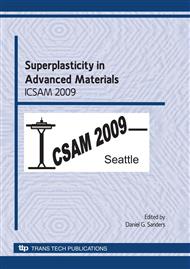p.69
p.77
p.85
p.93
p.103
p.113
p.119
p.125
p.135
High Pressure Waterjets – An Innovative Means of Alpha Case Removal for Superplastically Formed Titanium Alloys
Abstract:
Ultra high-pressure waterjets (WJ) have gained consideration as a viable alternative to conventional material removal and cleaning methods such as chemical milling, grit blasting, and grinding. Waterjets have often been considered for the stripping of unwanted coatings, but they also exhibit an inherent ability for the controlled milling of metallic materials. The waterjet material removal process poses a secondary benefit – the material erosion occurs due to the repetitive impact of droplets within the waterjet stream, which also serve to induce compressive residual stresses in the shallow sub-surface layers of the work piece. An experimental study was conducted to explore the removal of the alpha case layer on Superplastically Formed conventional and fine grain Ti-6Al-4V specimens. The resulting surface roughness parameters and completeness of alpha layer removal were characterized. Based on the experimental results, waterjet removal processes may serve as an alternate method for the post-processing of Superplastically Formed titanium alloys.
Info:
Periodical:
Pages:
103-111
Citation:
Online since:
March 2010
Authors:
Keywords:
Price:
Сopyright:
© 2010 Trans Tech Publications Ltd. All Rights Reserved
Share:
Citation:


